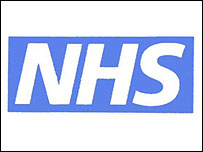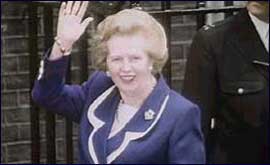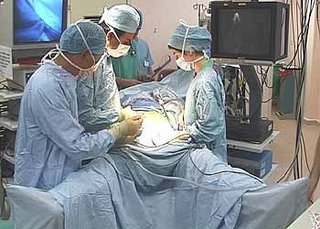
A BRIEF HISTORY OF THE
NATIONAL HEALTH SERVICE (PART 4)
The Arrival of Thatcherism and the Need For Accountability 1978 to 1992
It has always been difficult to be rational and objective about the NHS : "The NHS is the closest thing the English (sic) have to a religion, with those who practise in it regarding themselves as a priesthood. 'this made it quite extraordinarily difficult to reform" (N. Lawson - Chancellor of the Exchequer- , The View from Number Eleven, 1992).
The period from 1978 to the early nineties was characterised by the growing acknowledgement that clear financial bounds existed within which the NHS operated. It simply could no longer do everything that had become medically possible.
The NHS had become a victim of its own success. New technology was being introduced and more people were being treated in more complex ways. This led to both rising expectations of the health service and an increasingly elderly population with all its attendant health needs. What strikes me having researched the first fifty odd years of the NHS is how its main problems: funding, staffing, too much bureaucracy, medical advances etc have been part of the problem and the solution since day one. In the final part when I set-out how much we pay as individuals and how much we receive in return it's little wonder that the NHS is beset by problems and always will be however much money is thrown at it.
General management
Beginning in 1978 with what was dubbed by the newspapers as the winter of discontent, the service's financial problems were worsened by the oil crisis.
NHS management tried to improve efficiency and there were attempts to set priorities in 1979, to restructure the NHS again in 1982 and to introduce a tier of general management between 1983 and 1985.
The 1979 change of Government brought little immediate change in health service policy, as attempts to equalise the allocation of resources between different parts of the country continued.
The Thatcher Reforms
Margaret Thatcher was not particularly sure enough of her position as Conservative leader to plunge herself into major reforms of a national institution which was well liked by the British public. Also, Thatcher was by no means a specialist on health matters and so was unsure of the route to follow.

It's a one-off - honest guv!
When she eventually set about reforming the NHS, which began to take place in her third term as PM, she adopted the same principles she had followed in the rest of her policies. The key idea was internal competition. In 1987, the NHS was facing a real crisis : for example, there were severe difficulties in recruiting enough nursing staff because of low pay and conditions.
My grandmother was a nurse for more than fifty years and she saw it more as a vocation than a profession or career path, this mainfested itself in the fact that when she retired as a nurse, aged 60, she worked as a volunteer, delivering meals on wheels, for the next ten years - helping the 'old people' as she put it. In the late twentieth century however Nursing was seen as a career, unfortunately the pay meant that you had to have more than dedication to commit yourself to the NHS for life.
In 1987, Riverside Health Authority, covering central London north of the Thames, was more than 600 nurses short. For 20 years nursing had been a buyer's market : the NHS had been besieged by young women eager to join. It did not matter that one in three student nurses never finished the course or that a thousand gave up as soon as they passed their examinations. There were always more recruits. In the mid 80s however market forces started to thin out the ranks of nurses. With the explosion in "white blouse employment" (service industries), more and more trained young women are being employed in department stores, banking, insurance offices.
In the period 1985-1987, the Government rejected the pay increases proposed by the Nurses' Pay review body. The tight cash limits imposed on the public sector would be blown away if nurses were given the increase they should have received. And the private health sector in Britain, and even in the USA, is busy recruiting as many nurses in Britain as possible...
It was felt by many that the NHS had created a culture of dependency. The Conservatives therefore set about transferring the emphasis from "dependence" to "independence", by ending the "benefit culture". They encouraged people to make provision themselves for their own health and insurance, either through company or private cover. Personal pensions and private medicine were steps in this direction. General state welfare should be targeted at those in real need ("the safety net"), the very poorest, through a new form of means test. The first area to be targeted was child benefit (a benefit which had never been means-tested) : it was frozen despite a 1987 General Election promise to maintain it. Means-tested family credit was expanded. Housing benefit was cut. The budget of 1988 reduced top-rate income tax from 46% to 40%, whilst at the same time reducing benefits for some poor families.
And yet still, the medical profession remained sceptical about whether the Conservative Government had the future of the NHS at heart.In its first issue of 1988 the BMJ called for a new health commission.
"Let us be charitable. Let us assume that Mrs. Thatcher and her health ministers really do believe that the NHS is bigger and better funded than ever before and that the concern voiced by the health professions is whingeing in response to tough, effective management. Then how do we convince the government that the NHS is moving towards terminal decline, and that innovatory thinking is needed to solve the crisis? . . . The message is that after years of squeezing the NHS has finally no more juice to give . . . Britain is not alone in facing a health crisis; in every Western country each year brings new and better treatments for populations that are living longer than ever. This is the insatiable demand that politicians have been citing to excuse their refusal to find more money. But in fact there are many ways of skinning the cat. "
Medical and Technological Advances
Advances spanned all fields of NHS activity: primary health care was improving, although less so in the inner cities. Genetic engineering was yielding its first drug successes and magnetic resonance imaging was introduced. 1988 saw the introduction of the MMR vaccine and the following year the Hepatitis C virus was discovered.
The first of a new generation of antidepressants, fluoxetine (Prozac), was introduced in 1987. These selective serotonin re-uptake inhibitors worked by increasing levels of serotonin, a neurotransmitter. Unlike previous antidepressants, they appeared to have fewer side effects, and by 1995 some 500,000 people in Britain were taking them, including children.
Reserpine was found to be effective in schizophrenia. A new drug with some, albeit modest, effect on Alzheimer's disease (Aricept) was introduced. Sumatriptan helped migraine. The management of night-time asthma was improved by the introduction of salmeterol, a long-acting inhaled beta-2 agonist that produced effective relief for 12 hours and in 1998 sildenafil (Viagra) achieved instant cult status as an effective treatment for male impotence.
On the surgical side, the decade saw the advent of minimal access techniques, while the number of operations for fractured neck or femur and osteoarthritis of the hip was reaching almost epidemic proportions.
Minimal Access Surgery, also known as laparoscopic surgery, endoscopy and keyhole surgery really took off in the early nineties due to advances in the minituriastion of cameras and surgical tools. The size of the 'keyhole' can be as small as 5-15 mm across and the benefits to the patient are less scarring, less pain, shorter hospital stays (which of course is an advantage to the hospital) and to the hospital and its consultants it offers the chance to improve surgical techniques - this is one area in the NHS where the demand (pull) from the patients and the (push) from technological advances has seen surgeons embrace the new techniques without their usual reluctance or resistance.

A laparoscopic operation.
The most recent developments have seen fibreoptic light sources used, colour cameras and multiple television monitors so that all those in the room can examine the proceedings.
A Loss of Public Confidence
In 1986 there was an outbreak of a brain disease in cattle in southwest Britain. The condition, bovine spongiform encephalopathy (BSE), was thought to be related to Creutzfeldt-Jakob disease (CJD), scrapie and kuru, all forms of degenerative brain disease transmissible by food; it appeared that the sick animals had been fed meat products. A working party recommended in 1988 that sick animals be destroyed and BSE was made a notifiable disease. The government banned feed products made from ground cattle and sheep remains and ordered the slaughter of infected livestock. How effectively these measures were carried out was open to question.
A ten-year debate began, marked by contradiction, warning from meat producers against hysteria and unwavering reassurance from the government. Concern mounted in 1995 about transmission to humans when three farmers died of the disease; the media sounded alarm bells because it was a newsworthy story, government took a low key approach to prevent unwarranted panic, and medical scientists were divided in the evaluation of the possibility. In 1996 ten cases of a highly stereotyped variant of CJD in people below the age of 42 years pointed to a link between BSE and CJD, and strengthened the possibility of transmission from animals to humans.
The credibility of government advice on public health issues had been undermined.
Community Health
Clinical advances placed increasing demands on nursing and medical staff, and each profession looked at its education and organisation. One option for the NHS was to move care from a hospital to a community setting. Community nursing was examined and the Government established a review of general practice and primary health care.
Yet by 1987 health authorities throughout the country were in debt, waiting lists were growing and hospital wards were being closed - despite evidence of higher spending, steady increases in staff numbers and the treatment of more patients.
Neither the public nor the health care professions were satisfied and the service was increasingly subjected to scrutiny in the media.
The Internal Market is Born
The NHS experienced the most significant cultural shift since its inception with the introduction of the so-called internal market, outlined in the 1989 White Paper, Working for Patients, and which passed into law as the NHS and Community Care Act 1990.
The internal market was the Conservative Government's attempt to address problems, such as growing waiting lists, which had arisen in the 1980s as a result of NHS resources being constrained while demand rose inexorably.
Before the 1990 Act a monolithic bureaucracy ran all aspects of the NHS. After the establishment of the internal market, 'purchasers' (health authorities and some family doctors) were given budgets to buy health care from 'providers' (acute hospitals, organisations providing care for the mentally ill, people with learning disabilities and the elderly, and ambulance services).
To become a 'provider' in the internal market, health organisations became NHS trusts, independent organisations with their own managements, competing with each other.
NHS trusts
The first wave of 57 NHS Trusts came into being in 1991. By 1995, all health care was provided by NHS trusts. Over the same period, many family doctors were also given their own budgets with which to buy health care from NHS trusts in a scheme called GP fund holding. Not all GPs joined this scheme and their budgets were still controlled by health authorities, which bought health care 'in bulk' from NHS trusts.
GP fund holders
Patients of GP fund holders were often able to obtain treatment more quickly than patients of non-fund holders. This led to accusations of the NHS operating a two tier system, contrary to the founding principles of the NHS of fair and equal access for all to health care.
However, a quck read through the previous three parts of this story show that there always was an element of a two tier system that Governments encouraged and at the same time tried to resist.
Observers credit the internal market with improving cost consciousness in the NHS, but at a price: that the competition it encouraged between 'providers' saw unnecessary duplication of services.
But in 1997 there was a change of Government heralding yet another a new approach, another new strategy and another blueprint for the future.
It doesn't matter what decade you are in, there's always time for a reform of the NHS.
to be continued.................................
No comments:
Post a Comment